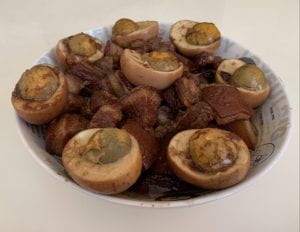General Information About Item:
- Material Lore, Christmas Food Recipe
- Language: English
- Country of Origin: United States
- Informant: Bing Hai
- Date Collected: 10-24-2021
Informant Data:
- Bing Hai is a 50-year old woman of Chinese descent living in Palo Alto, California. She is also the mother of the collector. Bing was born in Shenyang, China and immigrated to the United States upon finishing college in Beijing. She works on the patent counsel for Bristol Myers Squibb and has two college-aged children.
Contextual Data:
- Cultural Context: Bing learned to cook Chinese food at a very young age – she has a large repertoire of Chinese recipes that she can make at a moment’s notice. However, having lived in the United States for three decades, she has become skilled at cooking various American foods as well. Bing has celebrated most popular American holidays, including Christmas. Moreover, in Chinese culture, simple noodle dishes are considered a staple. Historically, many areas of China are relatively poor and live off of grains and rice. Throughout thousands of years, generations of Chinese people have depended on and passed down simple food recipes such as the cold noodle dish outlined here.
- Social Context: This food recipe was shared when the interviewee was asked about the specific foods she makes for Christmas dinner. As the primary chef in the household, Bing has a lot of experience preparing large amounts of food for various family dinners.
Item:
- Cold noodles (and other simple noodle dishes) are a notoriously easy dish to prepare in Chinese culture. For this recipe, you boil noodles until cooked and immediately place them in ice water to cool them down. Then, you prepare a sauce mixture with soy sauce, sesame oil, sugar, and scallions. Simply toss the cold noodles with the sauce mixture, and finish with sliced cucumbers and more scallions. The noodles are filling, easy to make, and can be prepared quickly in large quantities.
Transcript:
- “The dish I most enjoy making on Christmas is 凉面 (cold noodles). They are so easy to make, and I can make an enormous amount for the 10+ people who we invite on Christmas. You boil the noodles in water, take them out, and rest them in ice water. Your sauce is simply soy sauce, sesame oil, sugar, and scallions. Then you just mix the noodles and sauce, and slice some cucumbers and more scallions to put on top.”
Informant’s Comments:
- “The kids especially love this dish since it’s so pleasing to the palette, and the noodles really serve as the main carbs for the dinner.”
Collector’s Comments:
- I chose to ask my own mother about her Christmas food preparations, given that we come from a Chinese background and our Christmas dinner tends not to include traditionally American foods. As America becomes a melting pot of cultures and ethnicities, I found it useful to examine how minorities celebrate Christmas from the perspective of food. My mother echoed the overarching theme from my interviews – families tend to invite a lot of folks to Christmas dinner and choose to prepare whatever dishes are easiest to make in large quantities. This cold noodles recipe is many Chinese families’ go-to dish for large family dinners and therefore for Christmas dinner – it is folkloric in nature as many in the Chinese-American folk group will create this dish for large meals.
Collected By:
Evan Fu, 21
Palo Alto, CA
Hanover, NH
Dartmouth College
RUSS013
Fall 2021

